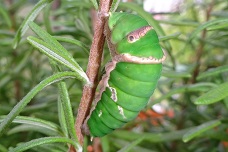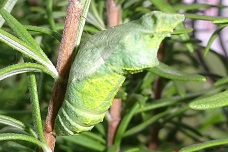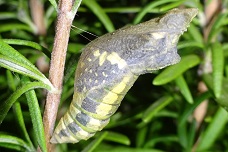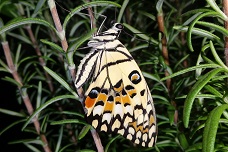| Home | Nature Weekly Index |
29 May 2016 | Wild Visitors | Beetles and Caterpillar |
The last time that I did a write up on wild visitors to my home was in June 2015. Since then, they continued to come occasionally. Some attracted by the pest insects (e.g. aphids) feasting on my plants, such as the syrphid fly larva on the hibiscus and the lacewing larva on the Chinese Motherwort plant. In term of quantity, the flying termites and flying ants were the most frequent visitors especially after heavy rain. The more exotic ones usually appeared alone.
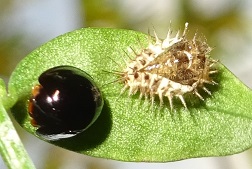 Last week, an exotic specimen came along that prompted me to did this consolidation. It was a pitch
black ladybird beetle (Chilocorus nigrita)
except for a small part of its head region which was yellowish brown. The beetle was found under a leaf of the
King of Bitters herb (Andrographis paniculata) growing in one
of my pots. The most fascinating part was that beside it, there was a pupa cast; indicating that it might be a newly hatch
beetle. This ladybird beetle is known for its predatory behaviour on scale insects in which its potential as a potential
agents for biological control had been explored way back in the late 90s. I surveyed the nearby plant parts and sure enough,
there were many scale insects on both the leaves and stems. I had previously named this black ladybird beetle as
Coelophora inaequalis based on the information from
Beetle@SG Blog, but had
changed my mind after seeing the pupa cast and read some articles related to Chilocorus nigrita.
Last week, an exotic specimen came along that prompted me to did this consolidation. It was a pitch
black ladybird beetle (Chilocorus nigrita)
except for a small part of its head region which was yellowish brown. The beetle was found under a leaf of the
King of Bitters herb (Andrographis paniculata) growing in one
of my pots. The most fascinating part was that beside it, there was a pupa cast; indicating that it might be a newly hatch
beetle. This ladybird beetle is known for its predatory behaviour on scale insects in which its potential as a potential
agents for biological control had been explored way back in the late 90s. I surveyed the nearby plant parts and sure enough,
there were many scale insects on both the leaves and stems. I had previously named this black ladybird beetle as
Coelophora inaequalis based on the information from
Beetle@SG Blog, but had
changed my mind after seeing the pupa cast and read some articles related to Chilocorus nigrita.
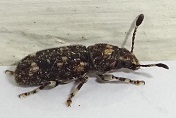 In the same week, I spotted another tiny elongated beetle on the surface of a low cabinet in my kitchen. Its length was
about 1 centimetre. I had almost missed it since its dark brown body colour was the same as that of the cabinet. At first,
I thought it was a dead beetle as it was motionless. While I placed it on a brighter surface to take some pictures, it
suddenly started to move. Due to its tiny size, I had to enlarge the pictures in my computer to figure out which group of
beetles it belongs to. Looking at the broad feature of its antennae, I first thought that it might be a Lizard Beetle. It
was not too difficult to pin down its identity from the Beetle@SG website. It turned out to
be a Fungus Weevil (Eucorynus crassicornis).
In the same week, I spotted another tiny elongated beetle on the surface of a low cabinet in my kitchen. Its length was
about 1 centimetre. I had almost missed it since its dark brown body colour was the same as that of the cabinet. At first,
I thought it was a dead beetle as it was motionless. While I placed it on a brighter surface to take some pictures, it
suddenly started to move. Due to its tiny size, I had to enlarge the pictures in my computer to figure out which group of
beetles it belongs to. Looking at the broad feature of its antennae, I first thought that it might be a Lizard Beetle. It
was not too difficult to pin down its identity from the Beetle@SG website. It turned out to
be a Fungus Weevil (Eucorynus crassicornis).
Last but not least, I had the honour to host another caterpillar on my balcony area. The host plant this time round was a Calamansi plant (Citrus x microcarpa) where in the previous round back in 2010, a Herb-of-grace plant (Ruta graveolens) had played the host. Strangely for the current round, I had not taken a single picture of this Lime Butterfly caterpillar (Papilio demoleus malayanus) until it migrated to the next pot on 14 May to hang its pupa on the Rosemary plant (Salvia rosmarinus). My attention had gone to other happenings in the other pots. Also, I was not too confident that this caterpillar could go all the way to the pupa sage without being eaten creatures roaming my balcony area. I often seen birds patrolling the balcony area and a number of caterpillars in the past simply vanished though I had not witness the actual feasting by the birds. Nevertheless, it had been quite some years now since I last saw a pupa on my balcony. Ten days later on 24 May, the pupa turned translucent with the pre-form butterfly vaguely visible. I knew the new birth was imminent. As predicted, the miraculous event took place the next morning at around 6 am.
